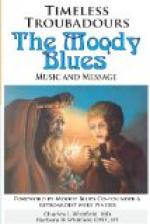per nos e adoratz,
e.l preguem que.ens don patz
a tota nostra via.
La nuech vai e.l jorns ve
ab elar eel e sere,
e l’alba no’s rete
ans ven belh’ e complia.
“True God, in Thy name and in the name of Saint Mary will I awake henceforth, since the star of day rises from o’er Jerusalem, bidding me say, ’Up and arise, sirs, who love God! For the day is nigh, and the night departs; and let God be praised and adored by us and let us pray Him that He give us peace for all our lives. Night goes and day comes with clear serene sky, and the dawn delays not but comes fair and perfect.’”
At the close of the Albigeois crusade the Virgin Mary becomes the theme of an increasing number of lyric poems. These are not like the farewells [92] to the world, uttered by weary troubadours, and dictated by individual circumstances, but are inspired by an increase of religious feeling in the public to whom the troubadours appealed. Peire Cardenal began the series and a similar poem is attributed to Perdigon, a troubadour who joined the crusaders and fought against his old patrons; though the poem is probably not his, it belongs to a time but little posterior to the crusade. The cult of the Virgin had obvious attractions as a subject for troubadours whose profane songs would not have been countenanced by St Dominic and his preachers and religious poetry dealing with the subject could easily borrow not only the metrical forms but also many technical expressions which troubadours had used in singing of worldly love. They could be the servants of a heavenly mistress and attribute to her all the graces and beauty of form and character. It has been supposed that the Virgin was the mysterious love sung by Jaufre Rudel and the supposition is not inconsistent with the language of his poems. Guiraut Riquier, the last of the troubadours, provides examples of this new genre: from the fourteenth century it was the only kind of poem admitted by the school of Toulouse and the Jeux Floraux crowned many poems of this nature. These, however, have little in common with classical troubadour poetry except language. The following stanzas from [93] the well-known hymn to the Virgin by Peire de Corbiac, will give an idea of the character of this poetry.
Domna, rosa ses espina,
sobre totas flors olens,
verga seca frug fazens,
terra que ses labor grana,
estela, del solelh maire,
noirissa del vostre paire,
el mon nulha no.us semelha
ni londana ni vezina.
Domna, verge pura e fina,
ans que fos l’enfantamens,
et apres tot eissamens,
receup en vos carn humana
Jesu Crist, nostre salvaire,
si com ses trencamen faire
intra.l bels rais, quan solelha,
per la fenestra veirina.
Domna, estela marina
de las autras plus luzens,
la mars nos combat e.l vens;
mostra nos via certana;
car si.ns vols a bon port traire
non tem nau ni governaire
ni tempest que.ns destorbelha
ni.l sobern de la marina.




